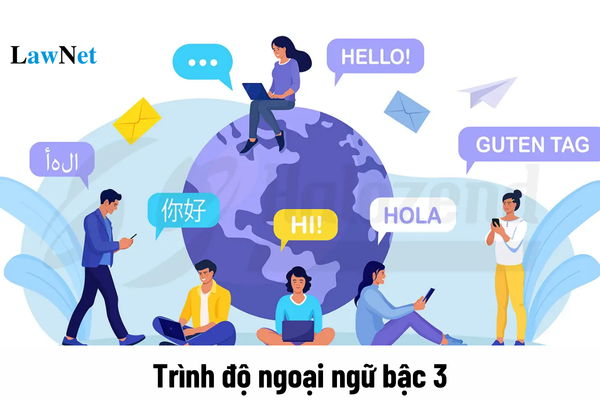Which level of CEFR framework is equal to level 3 foreign language proficiency on the 6-level Framework of the Foreign Language Proficiency Framework of Vietnam?
Which level of CEFR framework is equal to level 3 foreign language proficiency on the 6-level Framework of the Foreign Language Proficiency Framework of Vietnam?
According to Section 3 of the 6-level Foreign Language Proficiency Framework used in Vietnam, issued in conjunction with Circular 01/2014/TT-BGDDT, the specific regulations on the foreign language proficiency framework are as follows:
The foreign language proficiency framework, based on the CEFR reference framework, is divided into following levels as follows:
- Basic: Level 1 A1, level 2: A2
- Intermediate: Level 3 is B1, level 4 is B2
- Advanced: Level 5 is C1, level 6 is C2
Thus, according to the above regulations, level 3 language proficiency on the 6-level framework is equivalent to B1.

Which level of CEFR framework is equal to level 3 foreign language proficiency on the 6-level Framework of the Foreign Language Proficiency Framework of Vietnam? (Image from the Internet)
What are the skill requirements for each level in Vietnam?
According to sub-section 1 of Section 4 of the 6-level Foreign Language Proficiency Framework used in Vietnam, issued in conjunction with Circular 01/2014/TT-BGDDT, the specific regulations on the foreign language proficiency framework are as follows:
- Level 1: Students can understand and use familiar everyday expressions and basic phrases to meet specific communication needs. Students can introduce oneself and others, and can answer questions about personal details such as where they live, family and friends, etc. Students can communicate easily, provided the other person talks slowly, clearly, and is willing to help.
- Level 2: Students can understand sentences and frequently used expressions related to basic communication needs (such as information about personal and family, shopping, local geography, employment). Students can exchange information on familiar topics of routine interest. Students can provide a simple description of their background, immediate environment, and matters in areas of immediate need.
- Level 3: Students can understand the main points of clear standard input on familiar matters regularly encountered in work, school, leisure, etc. Students can handle most situations likely to arise while traveling in an area where the language is spoken. Students can produce simple connected text on topics that are familiar or of personal interest. Students can describe experiences, events, dreams, hopes, and ambitions and briefly give reasons and explanations for opinions and plans.
- Level 4: Students can understand the main ideas of complex text on both concrete and abstract topics, including technical discussions in their field of specialization. Students can interact with a degree of fluency and spontaneity that makes regular interaction with native speakers quite possible. Students can produce clear, detailed text on a wide range of subjects and explain a viewpoint on a topical issue giving the advantages and disadvantages of various options.
- Level 5: Can understand a wide range of demanding, longer texts, and recognize implicit meaning. Can express ideas fluently and spontaneously without much obvious searching for expressions. Can use language flexibly and effectively for social, academic, and professional purposes. Can produce clear, well-structured, detailed text on complex subjects, showing controlled use of organizational patterns, connectors, and cohesive devices.
- Level 6: Students can understand with ease virtually everything heard or read. Students can summarize information from different spoken and written sources, reconstructing arguments and accounts in a coherent presentation. Students can express themselves spontaneously, very fluently, and precisely, differentiating finer shades of meaning even in more complex situations.
What is the purpose of the language proficiency framework in Vietnam?
According to Section 1 of the 6-level Foreign Language Proficiency Framework used in Vietnam, issued in conjunction with Circular 01/2014/TT-BGDDT, the specific regulations on the foreign language proficiency framework are as follows:
- Serves as a unified basis for competency requirements for all languages taught in the national education system.
- Acts as a basis for developing curricula, writing or selecting textbooks, teaching plans, and other foreign language teaching materials, as well as criteria for testing, exams, and assessments at each educational level, ensuring connectivity in foreign language training across different education levels and formats.
- Provides a basis for teachers and lecturers to select and implement teaching content and methods, tests, and assessments to meet the program's training requirements.
- Assists learners in understanding the content and requirements for each language proficiency level and in self-assessing their competencies.
- Facilitates cooperation, educational exchange, and mutual recognition of degrees and certificates with countries that apply the Common European Framework of Reference for Languages (CEFR).

